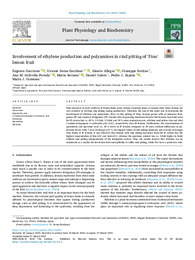Título :
Involvement of ethylene production and polyamines in rind pitting of ‘Fino’ lemon fruit |
Autor :
Guccione, Eugenia
Serna-Escolano, Vicente
Allegra, Alessio
Sortino, Giusseppe
Solivella-Poveda, Ana M.
Serrano, María
Valero, Daniel
Zapata, Pedro J.
Giménez, María J. |
Editor :
Elsevier |
Departamento:
Tecnología agroalimentaria |
Fecha de publicación:
2025 |
URI :
https://hdl.handle.net/11000/38012 |
Resumen :
Rind disorders in early cultivars of lemon fruits cause serious economic losses at market since these lemons are
very sensitive to develop rind pitting during postharvest. Therefore, the aim of this study was to determine the
involvement of ethylene and polyamines (PAs) in rind pitting of ‘Fino’ lemons grown with an intensive fertigation (IF) and standard fertigation (SF). Results after degreening treatment showed that lemons harvested from
the IF system had ca. 48 %, 3.5-fold, 2.5-fold and 28 % more respiration rate, ethylene production, free and total
1-aminocyclopropane-1-carboxylic acid (ACC), respectively, than SF lemons. Furthermore, the concentrations of
spermidine and spermine were ca. 30 % lower in IF lemons compared to SF ones, without differences in putrescine levels. After 7 days of storage at 8 ◦C, the highest values of rind pitting incidence and severity of damage
were found in IF lemons. It was observed that lemons with rind pitting harvested from the IF system had the
highest concentration of free-ACC and total-ACC, whereas the spermine content was ca. 3-fold higher in fruits
without rind pitting independently of the fertigation system. Thus, the results showed that ethylene can be
considered as a marker for the lemon fruit susceptibility to suffer rind pitting, while PAs have a protective role.
|
Área de conocimiento :
CDU: Ciencias aplicadas |
Tipo de documento :
info:eu-repo/semantics/article |
Derechos de acceso:
info:eu-repo/semantics/openAccess |
DOI :
https://doi.org/10.1016/j.plaphy.2025.109851 |
Publicado en:
Plant Physiology and Biochemistry. Volume 223 |
Aparece en las colecciones:
Artículos Tecnología Agroalimentaria
|
 La licencia se describe como: Atribución-NonComercial-NoDerivada 4.0 Internacional.
La licencia se describe como: Atribución-NonComercial-NoDerivada 4.0 Internacional.
.png)
